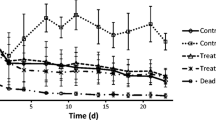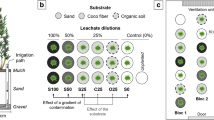Abstract
Background
Cyanide is found predominantly in industrial effluents generated by metallurgical operations. It is an extremely toxic compound, so that problems and catastrophic accidents have recently occurred all around the globe. The goal of this study was to determine the toxicity of cyanide to a Chinese willow species, and to determine the removal capacity.
Methods
The toxicity of potassium cyanide (KCN) to weeping willow trees (Salix babylonica L.) was tested. The normalized, relative transpiration of the plants was used to determine the phytotoxicity of cyanide. The cyanide removal capacity of weeping willows was also determined.
Results and Discussion
In hydroponic solution, no chlorosis of leaves and only a small reduction in normalized relative transpiration was observed when weeping willows were exposed to low doses of cyanide (0.93 mg CN/L). Severe signs of toxicity were found for the treatment groups exposed to higher doses of cyanide (9.3 mg CN/L). Weeping willows grown in sandy soils survived the entire period (216 hours) without any toxic effect when irrigated with low doses of cyanide (3.72 mg CN/L). High doses of cyanide (18.6 mg CN/L) in irrigation water were fatal for the weeping willows within 216 hours. EC50 values for a 50% inhibition of the transpiration of the trees were estimated to be between 3.27 and 8.23 mg CN/L, depending on the duration of the exposure.
Conclusions
The results obtained for the Chinese willow species Salix babylonica were very similar to those obtained for the European species S. viminalis in earlier studies. Phytotoxic effects were only found at high doses of cyanide. A large proportion of applied cyanide was removed from the contaminated media in the presence of weeping willows. This gives rise to the conclusion that the metabolism of cyanide by weeping willows is possible.
Recommendations and Outlook
Cyanide elimination with trees seems to be a feasible option for cleaning soils and water contaminated with cyanide. A full-scale treatment has been installed in Denmark. For phytoremediation projects in China, weeping willow could be a suitable species. The tree can tolerate and remove cyanide, and it is a native Chinese species. Besides, the tree is of outstanding beauty and is planted as a common park tree in many parts of the world.
Similar content being viewed by others
Author information
Authors and Affiliations
Corresponding authors
Rights and permissions
About this article
Cite this article
Yu, X., Trapp, S. & Zhou, P. Phytotoxicity of Cyanide to Weeping Willow Trees. Env Sci Poll Res Int 12, 109–113 (2005). https://doi.org/10.1065/espr2005.02.237
Received:
Accepted:
Published:
Issue Date:
DOI: https://doi.org/10.1065/espr2005.02.237




